A Review of Emerging Technologies for IoT-Based Smart Cities
Abstract
1. Introduction
- We discuss the overall smart city concept in the context of cloud, edge, and IoT ecosystems.
- We present IoT-enabled essential technologies, and architectures for overall discussions in different scenarios.
- We present IoT-enabled machine learning, challenges, applications, and security and privacy concerns with recent emerging technologies including blockchain.
- We provide an IoT-based framework for smart cities in the context of emerging technologies.
- We discuss and outline the technical challenges and applications of the smart city in the context of recently emerging technologies.
2. Background
2.1. Smart City 1.0
2.2. Smart City 2.0
2.3. Smart City 3.0
2.4. Smart City 4.0
2.5. Smart City 5.0
| ID | Sectors | Key Services | Advantages | Core Issues |
|---|---|---|---|---|
| [15] | Agriculture, Building | Built a testbed to simulate large-scale IoT deployments and produced CoAP and MQTT data | Cost-efficient | Did not support more request per seconds |
| [16] | Traffic Light system | Shows waiting time and vehicle density | Improve travel time, road safety, reduce traffic | — |
| [17] | Smart Parking | Availability of parking space | Save time, energy consumption | Does not take the weather or social events into account |
| [18] | Smart Home | Automation | High speed, multitasking | Low cost capacity |
| [19] | Smart building | Electronics embedded system | Improve quality of life | Affects monitoring tasks |
| [20] | Smart waste management | Management | Separate organic and recyclable waste | Less public spaces |
| [21] | Blockchain and smart city | Evaluate blockchain technologies | Provide reliability and secure services | High energy consumption |
| [22] | Smart Lighting | Evaluate various protocols | Save energy | Less security system, high installation cost |
| [23] | Cloud and smart city | Collecting and transmitting data | Energy management, waste management, reduce gas emission | — |
3. IoT Technologies for Smart Cities
3.1. Message Queuing Telemetry Transport (MQTT)
3.2. Raspberry Pi
3.3. Actuator
3.4. Radio Frequency Identification (RFID)
3.5. Sensor
3.6. Global Positioning System (GPS)
4. IoT-Based Computational Infrastructure
4.1. Cloud Computing
4.2. Fog Computing
4.3. Edge Computing
5. IoT Architecture and Data Processing
5.1. IoT Architecture
5.1.1. User Interface
5.1.2. Mode of Transmission
5.1.3. Central Controller
5.2. Data Processing
5.2.1. Sensor Layer
5.2.2. Network Layer
5.2.3. Analysis Layer
5.2.4. Application Layer
6. IoT and Machine Learning
6.1. Applications
6.1.1. Health Disease Prediction
6.1.2. Road Accident Prediction
6.1.3. Industry Maintenance
6.1.4. Smart Agriculture
6.2. Machine Learning on Security and Privacy for Smart Cities
6.3. Challenges of Using Machine Learning with IoT
6.3.1. False Data Detection
6.3.2. High Cost
6.3.3. Reliability
6.3.4. Data Labeling
6.3.5. Lack of Multitasking Capabilities
7. Security, Privacy, and Blockchain
7.1. Security and Privacy Issues
7.1.1. Lack of Encryption
7.1.2. Data Security
7.1.3. An Attack on Virtual Machines
7.1.4. Interoperability
7.2. Blockchain Challenges and Issues
7.2.1. Uncertainty
7.2.2. Privacy of Citizens
7.2.3. Standardization
7.2.4. Legal Uncertainty
7.2.5. DDoS Attack
7.3. Solution Approaches
7.3.1. Encryption-Based Solutions
7.3.2. Blockchain-Based Solutions
Smart Electronic Commerce
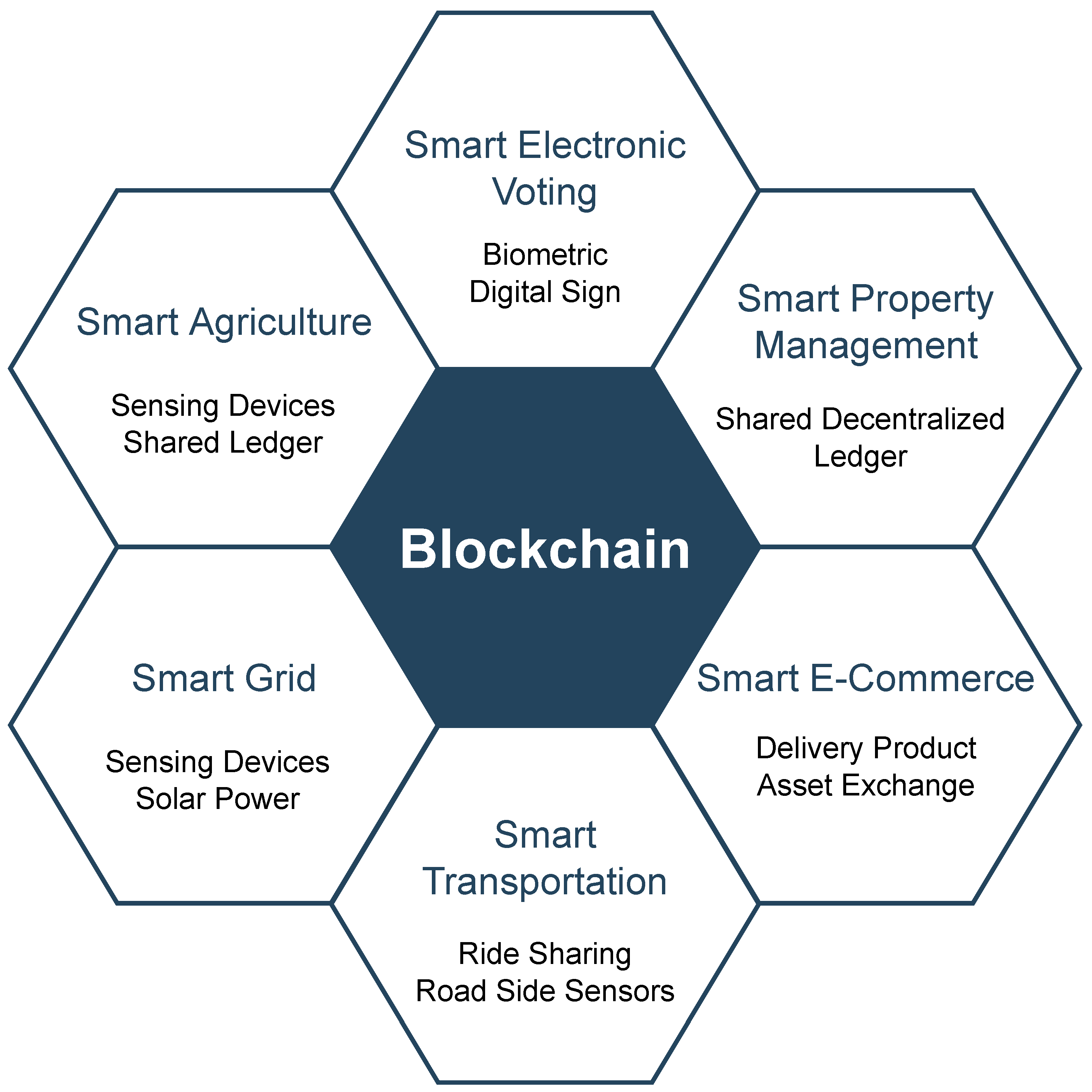
Smart Electronic Voting System
Smart Transportation System
Smart Grid
Smart Property Management
8. Smart Cities Experience and Mega Events
8.1. Experiencing Smart Cities Worldwide
8.2. Smart City Framework Perspective of Mega Events
9. Applications for Smart Cities
9.1. Waste Management System
9.2. Smart Parking System
9.3. Smart Traffic Light System
9.4. Smart Building System
| Field | Id | Algorithm | Goal | Advantage | Technology |
|---|---|---|---|---|---|
| Smart Waste Management System | [27] | WSN, IoT | Watch the trashcan | Lessen the challenges associated with cleaning procedures | Ultrasonic Sensor, Arduino UNO, Wi-Fi |
| [83] | Machine Learning, graph theory | Show the amount of waste in cans | Inexpensive, replaceable | LoRa | |
| [85] | Machine Learning, IoT | Waste collection and decomposition | Reuse energy | KNN | |
| Smart Building System | [13] | IoT, plug and play learning framework | HVAC controls | Avoiding a building-by-building arrangement | Sensor |
| [84] | IoT | Energy management of buildings | Lower installation cost | Power over Ethernet (PoE) | |
| [86] | WSN, IoT | Cost-effective, versatile, and reliable wellness sensor networks | Mobility of objects inside the home to predict a person’s health | ZigBee, A301, LM35 IC | |
| [87] | Data fusion Techniques | Establish a framework with spatio-temporal data | Low-cost hardware and software, save energy | Arduino microcontroller, WiFi | |
| Smart Parking System | [88] | IoT based Cloud | Availability of parking place is tracked | Bolster parking infrastructure | Ultrasonic Sensor, raspberry pi |
| [89] | Cloud+IoT | Automatically locate a cost-effective parking spot | increases parking attempt and reduces user waiting time | WSM, RFID | |
| [29] | Cloud based hybrid-parking model | Reduce the gridlock caused by parking issues | Offer the public the highest-quality services while making a profit | Ultrasonic Sensor, RFID | |
| [90] | E-parking system | Check for parking space availability and reserve a spot | Seeing automobiles parked improperly in the parking space | Wi-Fi | |
| Smart Traffic Light System | [16] | IoT and Adaptive Neuro Fuzzy Inference System (ANFIS) | A better traffic situation | boost the drivers’comfort and safety | Arduino UNO |
| [91] | GSM | Guarantee safety and avoid energy wastage | automated streetlight ON/OFF switching | Microcontroller MSP430, LDR sensor. | |
| [92] | Arduino board | To reduce the gridlock caused by parking issues | better performance | LED, HID lamps. |
10. IoT-Based Smart City Challenges and Solutions
10.1. Challenges
10.1.1. Assuring Data Quality
10.1.2. Security and Privacy
10.1.3. Reliability
10.1.4. Smart Sensors
10.2. IoT-Based Solution
11. Conclusions
Author Contributions
Funding
Conflicts of Interest
References
- Ashton, K. That ‘Internet of Things’ Thing. RFID J. 2009, 22, 97–114. [Google Scholar]
- Arasteh, H.; Hosseinnezhad, V.; Loia, V.; Tommasetti, A.; Troisi, O.; Shafie-khah, M.; Siano, P. IoT-based smart cities: A survey. In Proceedings of the 2016 IEEE 16th International Conference on Environment and Electrical Engineering (EEEIC), Florence, Italy, 7–10 June 2016; pp. 1–6. [Google Scholar]
- Sun, H.; Yu, H.; Fan, G. Contract-Based Resource Sharing for Time Effective Task Scheduling in Fog-Cloud Environment. IEEE Trans. Netw. Serv. Manag. 2020, 17, 1040–1053. [Google Scholar] [CrossRef]
- Datta, S.K.; Da Costa, R.P.; Bonnet, C.; Härri, J. One M2M architecture based IoT framework for mobile crowd sensing in smart cities. In Proceedings of the IEEE European Conference on Networks and Communications (EuCNC), Athens, Greece, 27–30 June 2016; pp. 168–173. [Google Scholar]
- Rajab, H.; Cinkelr, T. IoT based smart cities. In Proceedings of the International Symposium on Networks, Computers and Communications (ISNCC), Rome, Italy, 19–21 June 2018; pp. 1–4. [Google Scholar]
- Khan, A.; Aslam, S.; Aurangzeb, K.; Alhussein, M.; Javaid, N. Multiscale modeling in smart cities: A survey on applications, current trends, and challenges. Sustain. Cities Soc. 2022, 78, 103517. [Google Scholar] [CrossRef]
- Chatterjee, S.; Kar, A.K.; Gupta, M.P. Success of IoT in smart cities of India: An empirical analysis. Gov. Inf. Q. 2018, 35, 349–361. [Google Scholar] [CrossRef]
- Park, E.; Del Pobil, A.P.; Kwon, S.J. The role of Internet of Things (IoT) in smart cities: Technology roadmap-oriented approaches. Sustainability 2018, 10, 1388. [Google Scholar] [CrossRef]
- Abate, F.; Carratù, M.; Liguori, C.; Paciello, V. A low cost smart power meter for IoT. Measurement 2019, 136, 59–66. [Google Scholar] [CrossRef]
- Barriga, J.K.D.; Romero, C.D.G.; Molano, J.I.R. Proposal of a standard architecture of IOT for Smart Cities. In Proceedings of the International Workshop on Learning Technology for Education Challenges, Hagen, Germany, 25–28 July 2016; Springer: Cham, Switzerland, 2016; pp. 77–89. [Google Scholar]
- Rosemann, M.; Becker, J.; Chasin, F. City 5.0. Bus. Inf. Syst. Eng. 2021, 63, 71–77. [Google Scholar] [CrossRef]
- Sikder, A.K.; Acar, A.; Aksu, H.; Uluagac, A.S.; Akkaya, K.; Conti, M. IoT-enabled smart lighting systems for smart cities. In Proceedings of the IEEE 8th Annual Computing and Communication Workshop and Conference (CCWC), Las Vegas, NV, USA, 8–10 January 2018; pp. 639–645. [Google Scholar]
- Zhao, L.; Wang, J.; Liu, J.; Kato, N. Optimal edge resource allocation in IoT-based smart cities. IEEE Netw. 2019, 33, 30–35. [Google Scholar] [CrossRef]
- Ghazal, T.M.; Hasan, M.K.; Alshurideh, M.T.; Alzoubi, H.M.; Ahmad, M.; Akbar, S.S.; Al Kurdi, B.; Akour, I.A. Iman IoT for smart cities: Machine learning approaches in smart healthcare—A review. Future Internet 2021, 13, 218. [Google Scholar] [CrossRef]
- Araujo, V.; Mitra, K.; Saguna, S.; Åhlund, C. Performance evaluation of FIWARE: A cloud-based IoT platform for smart cities. J. Parallel Distrib. Comput. 2019, 132, 250–261. [Google Scholar] [CrossRef]
- George, A.M.; George, V.I.; George, M.A. IoT based smart traffic light control system. In Proceedings of the IEEE International Conference on Control, Power, Communication and Computing Technologies (ICCPCCT), Kannur, India, 23–24 March 2018; pp. 148–151. [Google Scholar]
- Ali, G.; Ali, T.; Irfan, M.; Draz, U.; Sohail, M.; Glowacz, A.; Sulowicz, M.; Mielnik, R.; Faheem, Z.B.; Martis, C. IoT based smart parking system using deep long short memory network. Electronics 2020, 9, 1696. [Google Scholar] [CrossRef]
- Paul, C.; Ganesh, A.; Sunitha, C. An overview of IoT based smart homes. In Proceedings of the IEEE 2nd International Conference on Inventive Systems and Control (ICISC), Coimbatore, India, 19–20 January 2018; pp. 43–46. [Google Scholar]
- Ahmed, Z.; Rawat, A.; Kumari, P. An Anaylsis of Iot Based Smart Cities. Int. J. Eng. Trends Appl. 2021, 8, 30–35. [Google Scholar]
- Marques, P.; Manfroi, D.; Deitos, E.; Cegoni, J.; Castilhos, R.; Rochol, J.; Pignaton, E.; Kunst, R. An IoT-based smart cities infrastructure architecture applied to a waste management scenario. Ad Hoc Netw. 2019, 87, 200–208. [Google Scholar] [CrossRef]
- Majeed, U.; Khan, L.U.; Yaqoob, I.; Kazmi, S.A.; Salah, K.; Hong, C.S. Blockchain for IoT-based smart cities: Recent advances, requirements, and future challenges. J. Netw. Comput. Appl. 2021, 181, 103007. [Google Scholar] [CrossRef]
- Gowda, V.D.; Annepu, A.; Ramesha, M.; Kumar, K.P.; Singh, P. Iot enabled smart lighting system for smart cities. J. Phys. Conf. Ser. 2021, 2089, 012037. [Google Scholar] [CrossRef]
- Simon, J.; Mester, G. Critical overview of the cloud-based internet of things pilot platforms for smart cities. Interdiscip. Descr. Complex Syst. INDECS 2018, 16, 397–407. [Google Scholar] [CrossRef]
- Anagnostopoulos, T.; Zaslavsky, A.; Kolomvatsos, K.; Medvedev, A.; Amirian, P.; Morley, J.; Hadjieftymiades, S. Challenges and opportunities of waste management in IoT-enabled smart cities: A survey. IEEE Trans. Sustain. Comput. 2017, 2, 275–289. [Google Scholar] [CrossRef]
- Patti, E.; Acquaviva, A. IoT platform for Smart Cities: Requirements and implementation case studies. In Proceedings of the IEEE 2nd International Forum on Research and Technologies for Society and Industry Leveraging a Better Tomorrow (RTSI), Bologna, Italy, 7–9 September 2016; pp. 1–6. [Google Scholar]
- Al-Sarawi, S.; Anbar, M.; Alieyan, K.; Alzubaidi, M. Internet of Things (IoT) communication protocols. In Proceedings of the IEEE 8th International Conference on Information Technology (ICIT), Amman, Jordan, 17–18 May 2017; pp. 685–690. [Google Scholar]
- Adam, M.; Okasha, M.E.; Tawfeeq, O.M.; Margan, M.A.; Nasreldeen, B. Waste management system using IoT. In Proceedings of the IEEE International Conference on Computer, Control, Electrical, and Electronics Engineering (ICCCEEE), Khartoum, Sudan, 12–14 August 2018; pp. 1–4. [Google Scholar]
- Santos, P.M.; Rodrigues, J.G.P.; Cruz, S.B.; Lourenço, T.; d’Orey, P.M.; Luis, Y.; Rocha, C.; Sousa, S.; Crisóstomo, S.; Queirós, C.; et al. PortoLivingLab: An IoT-based sensing platform for smart cities. IEEE Internet Things J. 2018, 5, 523–532. [Google Scholar] [CrossRef]
- Al-Turjman, F.; Malekloo, A. Smart parking in IoT-enabled cities: A survey. Sustain. Cities Soc. 2019, 49, 101608. [Google Scholar] [CrossRef]
- Arshad, R.; Zahoor, S.; Shah, M.A.; Wahid, A.; Yu, H. Green IoT: An investigation on energy saving practices for 2020 and beyond. IEEE Access 2017, 5, 15667–15681. [Google Scholar] [CrossRef]
- Stergiou, C.; Psannis, K.E.; Kim, B.; Gupta, B. Secure integration of IoT and cloud computing. Future Gener. Comput. Syst. 2018, 78, 964–975. [Google Scholar] [CrossRef]
- Mazumder, A.K.M.M.R.; Uddin, K.M.A.; Arbe, N.; Jahan, L.; Whaiduzzaman, M. Dynamic task scheduling algorithms in cloud computing. In Proceedings of the 3rd International Conference on Electronics, Communication and Aerospace Technology (ICECA), Coimbatore, India, 12–14 June 2019; pp. 1280–1286. [Google Scholar]
- Mukherjee, M.; Shu, L.; Wang, D. Survey of fog computing: Fundamental, network applications, and research challenges. IEEE Commun. Surv. Tutor. 2018, 20, 1826–1857. [Google Scholar] [CrossRef]
- Vaquero, L.M.; Rodero-Merino, L. Finding your way in the fog: Towards a comprehensive definition of fog computing. ACM SIGCOMM Comput. Commun. Rev. 2014, 44, 27–32. [Google Scholar] [CrossRef]
- Yu, W.; Liang, F.; He, X.; Hatcher, W.G.; Lu, C.; Lin, J.; Yang, X. A survey on the edge computing for the Internet of Things. IEEE Access 2017, 6, 6900–6919. [Google Scholar] [CrossRef]
- Wang, X.; Han, Y.; Leung, V.C.M.; Niyato, D.; Yan, X.; Chen, X. Convergence of edge computing and deep learning: A comprehensive survey. IEEE Commun. Surv. Tutor. 2020, 22, 869–904. [Google Scholar] [CrossRef]
- Whaiduzzaman, M.; Oliullah, K.; Mahi, M.J.N.; Barros, A. AUASF: An anonymous users authentication scheme for fog-IoT environment. In Proceedings of the 11th International Conference on Computing, Communication and Networking Technologies (ICCCNT), Kharagpur, India, 1–3 July 2020; pp. 1–7. [Google Scholar]
- Whaiduzzaman, M.; Mahi, M.J.N.; Barros, A.; Khalil, M.I.; Fidge, C.; Buyya, R. BFIM: Performance measurement of a blockchain based hierarchical tree layered fog-IoT microservice architecture. IEEE Access 2021, 9, 106655–106674. [Google Scholar] [CrossRef]
- Alavi, A.H.; Jiao, P.; Buttlar, W.G.; Lajnef, N. Internet of Things-enabled smart cities: State-of-the-art and future trends. Measurement 2018, 129, 589–606. [Google Scholar] [CrossRef]
- Hossen, R.; Whaiduzzaman, M.; Uddin, M.N.; Islam, M.J.; Faruqui, N.; Barros, A.; Sookhak, M.; Mahi, M.J.N. BDPS: An Efficient Spark-Based Big Data Processing Scheme for Cloud Fog-IoT Orchestration. Information 2021, 12, 517. [Google Scholar] [CrossRef]
- Al-Fuqaha, A.; Guizani, M.; Mohammadi, M.; Aledhari, M.; Ayyash, M. Internet of things: A survey on enabling technologies, protocols, and applications. IEEE Commun. Surv. Tutor. 2015, 17, 2347–2376. [Google Scholar] [CrossRef]
- Hammi, B.; Khatoun, R.; Zeadally, S.; Fayad, A.; Khoukhi, L. IoT technologies<? show [AQ ID= Q1]?> for smart cities. IET Netw. 2018, 7, 1–13. [Google Scholar]
- Zantalis, F.; Koulouras, G.; Karabetsos, S.; Kandris, D. A review of machine learning and IoT in smart transportation. Future Internet 2019, 11, 94. [Google Scholar] [CrossRef]
- Hussain, F.; Hussain, R.; Hassan, S.A.; Hossain, E. Machine learning in IoT security: Current solutions and future challenges. IEEE Commun. Surv. Tutor. 2019, 22, 1686–1721. [Google Scholar] [CrossRef]
- Atitallah, S.B.; Driss, M.; Boulila, W.; Ghézala, H.B. Leveraging Deep Learning and IoT big data analytics to support the smart cities development: Review and future directions. Comput. Sci. Rev. 2020, 38, 100303. [Google Scholar] [CrossRef]
- Mohan, S.; Thirumalai, C.; Srivastava, G. Effective heart disease prediction using hybrid machine learning techniques. IEEE Access 2019, 7, 81542–81554. [Google Scholar] [CrossRef]
- Liu, Z.; Yao, C.; Yu, H.; Wu, T. Deep reinforcement learning with its application for lung cancer detection in medical Internet of Things. Future Gener. Comput. Syst. 2019, 97, 1–9. [Google Scholar] [CrossRef]
- Dourado, C.M.J.M., Jr.; da Silva, S.P.P.; da Nobrega, R.V.M.; Barros, A.C.d.; Reboucas Filho, P.P.; de Albuquerque, V.H.C. Deep learning IoT system for online stroke detection in skull computed tomography images. Comput. Netw. 2019, 152, 25–39. [Google Scholar] [CrossRef]
- Faruqui, N.; Yousuf, M.A.; Whaiduzzaman, M.; Azad, A.K.M.; Barros, A.; Moni, M.A. LungNet: A hybrid deep-CNN model for lung cancer diagnosis using CT and wearable sensor-based medical IoT data. Comput. Biol. Med. 2021, 139, 104961. [Google Scholar] [CrossRef] [PubMed]
- Calabrese, M.; Cimmino, M.; Fiume, F.; Manfrin, M.; Romeo, L.; Ceccacci, S.; Paolanti, M.; Toscano, G.; Ciandrini, G.; Carrotta, A.; et al. SOPHIA: An event-based IoT and machine learning architecture for predictive maintenance in industry 4.0. Information 2020, 11, 202. [Google Scholar] [CrossRef]
- Brik, B.; Bettayeb, B.; Sahnoun, M.; Duval, F. Towards predicting system disruption in industry 4.0: Machine learning-based approach. Procedia Comput. Sci. 2019, 151, 667–674. [Google Scholar] [CrossRef]
- Akhter, R.; Sofi, S.A. Precision agriculture using IoT data analytics and machine learning. J. King Saud Univ. Comput. Inf. Sci. 2021, 34, 5602–5618. [Google Scholar] [CrossRef]
- Maduranga, M.W.P.; Abeysekera, R. Machine learning applications in IoT based agriculture and smart farming: A review. Int. J. Eng. Appl. Sci. Technol. 2020, 4, 24–27. [Google Scholar] [CrossRef]
- Amanullah, M.A.; Habeeb, R.A.A.; Nasaruddin, F.H.; Gani, A.; Ahmed, E.; Nainar, A.S.M.; Akim, N.M.; Imran, M. Deep learning and big data technologies for IoT security. Comput. Commun. 2020, 151, 495–517. [Google Scholar] [CrossRef]
- Bhattacharya, S.; Somayaji, S.R.K.; Gadekallu, T.R.; Alazab, M.; Maddikunta, P.K.R. A review on deep learning for future smart cities. Internet Technol. Lett. 2022, 5, e187. [Google Scholar] [CrossRef]
- Azmoodeh, A.; Dehghantanha, A.; Choo, K.R. Robust malware detection for internet of (battlefield) things devices using deep eigenspace learning. IEEE Trans. Sustain. Comput. 2018, 4, 88–95. [Google Scholar] [CrossRef]
- Meidan, Y.; Bohadana, M.; Mathov, Y.; Mirsky, Y.; Shabtai, A.; Breitenbacher, D.; Elovici, Y. N-baiot—Network-based detection of iot botnet attacks using deep autoencoders. IEEE Pervasive Comput. 2018, 17, 12–22. [Google Scholar] [CrossRef]
- Waheed, N.; He, X.; Ikram, M.; Usman, M.; Hashmi, S.S.; Usman, M. Security and privacy in IoT using machine learning and blockchain: Threats and countermeasures. ACM Comput. Surv. 2020, 53, 1–37. [Google Scholar] [CrossRef]
- Bostami, B.; Ahmed, M.; Choudhury, S. False data injection attacks in internet of things. In Performability in Internet of Things; Springer: Berlin/Heidelberg, Germany, 2019; pp. 47–58. [Google Scholar]
- Shafique, M.; Theocharides, T.; Bouganis, C.S.; Hanif, M.A.; Khalid, F.; Hafız, R.; Rehman, S. An overview of next-generation architectures for machine learning: Roadmap, opportunities and challenges in the IoT era. In Proceedings of the Design, Automation & Test in Europe Conference & Exhibition, Dresden, Germany, 19–23 March 2018; pp. 827–832. [Google Scholar]
- Kimani, K.; Oduol, V.; Langat, K. Cyber security challenges for IoT-based smart grid networks. Int. J. Crit. Infrastruct. Prot. 2019, 25, 36–49. [Google Scholar] [CrossRef]
- Roy, S.; Shovon, A.R.; Whaiduzzaman, M. Combined approach of tokenization and mining to secure and optimize big data in cloud storage. In Proceedings of the IEEE Region 10 Humanitarian Technology Conference (R10-HTC), Dhaka, Bangladesh, 21–23 December 2017; pp. 83–88. [Google Scholar]
- Rao, T.A.; Haq, E.U. Security challenges facing IoT layers and its protective measures. Int. J. Comput. Appl. 2018, 179, 31–35. [Google Scholar]
- Zaldivar, D.; Lo’ai, A.T.; Muheidat, F. Investigating the security threats on networked medical devices. In Proceedings of the IEEE 10th Annual Computing and Communication Workshop and Conference (CCWC), Las Vegas, NV, USA, 6–8 January 2020; pp. 488–493. [Google Scholar]
- Xie, J.; Tang, H.; Huang, T.; Yu, F.R.; Xie, R.; Liu, J.; Liu, Y. A survey of blockchain technology applied to smart cities: Research issues and challenges. IEEE Commun. Surv. Tutor. 2019, 21, 2794–2830. [Google Scholar] [CrossRef]
- Deshpande, A.; Stewart, K.; Lepetit, L.; Gunashekar, S. Distributed Ledger Technologies/Blockchain: Challenges, opportunities and the prospects for standards. Overv. Rep. Br. Stand. Inst. 2017, 40, 40. [Google Scholar]
- Zetzsche, D.A.; Buckley, R.P.; Arner, D.W. The distributed liability of distributed ledgers: Legal risks of blockchain. U. Ill. L. Rev. 2018, 2018, 1361. [Google Scholar] [CrossRef]
- Singh, R.; Sharma, R.; Akram, S.V.; Gehlot, A.; Buddhi, D.; Malik, P.K.; Arya, R. Highway 4.0: Digitalization of highways for vulnerable road safety development with intelligent IoT sensors and machine learning. Saf. Sci. 2021, 143, 105407. [Google Scholar] [CrossRef]
- Rasori, M.; Perazzo, P.; Dini, G. A lightweight and scalable attribute-based encryption system for smart cities. Comput. Commun. 2020, 149, 78–89. [Google Scholar] [CrossRef]
- Shen, M.; Tang, X.; Zhu, L.; Du, X.; Guizani, M. Privacy-preserving support vector machine training over blockchain-based encrypted IoT data in smart cities. IEEE Internet Things J. 2019, 6, 7702–7712. [Google Scholar] [CrossRef]
- Whaiduzzaman, M.; Farjana, N.; Barros, A.; Mahi, M.; Nayeen, J.; Satu, M.; Roy, S.; Fidge, C. HIBAF: A data security scheme for fog computing. J. High-Speed Netw. 2021, 27, 381–402. [Google Scholar] [CrossRef]
- Asgaonkar, A.; Krishnamachari, B. Solving the buyer and seller’s dilemma: A dual-deposit escrow smart contract for provably cheat-proof delivery and payment for a digital good without a trusted mediator. In Proceedings of the IEEE International Conference on Blockchain and Cryptocurrency (ICBC), Seoul, Republic of Korea, 14–17 May 2019; pp. 262–267. [Google Scholar]
- Hasan, H.R.; Salah, K. Proof of delivery of digital assets using blockchain and smart contracts. IEEE Access 2018, 6, 65439–65448. [Google Scholar] [CrossRef]
- Kshetri, N.; Voas, J. Blockchain in developing countries. IT Prof. 2018, 20, 11–14. [Google Scholar] [CrossRef]
- Laurent, V.; Guérard, A.; Mazerolles, C.; Le Gonidec, S.; Toulet, A.; Nieto, L.; Zaidi, F.; Majed, B.; Garandeau, D.; Socrier, Y.; et al. Periprostatic adipocytes act as a driving force for prostate cancer progression in obesity. Nat. Commun. 2016, 7, 1–15. [Google Scholar] [CrossRef]
- Emmanuel, M.; Rayudu, R. Communication technologies for smart grid applications: A survey. J. Netw. Comput. Appl. 2016, 74, 133–148. [Google Scholar] [CrossRef]
- Musleh, A.S.; Yao, G.; Muyeen, S.M. Blockchain applications in smart grid—review and frameworks. IEEE Access 2019, 7, 86746–86757. [Google Scholar] [CrossRef]
- Shedroff, N. Self-managing real estate. Computer 2018, 51, 104. [Google Scholar] [CrossRef]
- Hefnawy, A.; Bouras, A.; Cherifi, C. Integration of smart city and lifecycle concepts for enhanced large-scale event management. In Proceedings of the IFIP International Conference on Product Lifecycle Management, Doha, Qatar, 19–21 October 2015; Springer: Cham, Switzerland, 2015; pp. 687–697. [Google Scholar]
- Kubler, S.; Robert, J.; Hefnawy, A.; Cherifi, C.; Bouras, A.; Främling, K. IoT-based smart parking system for sporting event management. In Proceedings of the 13th International Conference on Mobile and Ubiquitous Systems: Computing, Networking and Services, Hiroshima, Japan, 28 November–1 December 2016; pp. 104–114. [Google Scholar]
- Santos, J.; Vanhove, T.; Sebrechts, M.; Dupont, T.; Kerckhove, W.; Braem, B.; Van Seghbroeck, G.; Wauters, T.; Leroux, P.; Latre, S.; et al. City of things: Enabling resource provisioning in smart cities. IEEE Commun. Mag. 2018, 56, 177–183. [Google Scholar] [CrossRef]
- Hashem, I.A.T.; Chang, V.; Anuar, N.B.; Adewole, K.; Yaqoob, I.; Gani, A.; Ahmed, E.; Chiroma, H. The role of big data in smart city. Int. J. Inf. Manag. 2016, 36, 748–758. [Google Scholar] [CrossRef]
- Anh Khoa, T.; Phuc, C.H.; Lam, P.D.; Nhu, L.M.B.; Trong, N.M.; Phuong, N.T.H.; Duc, D.N.M. Waste management system using IoT-based machine learning in university. Wirel. Commun. Mob. Comput. 2020, 2020, 6138637. [Google Scholar] [CrossRef]
- Minoli, D.; Sohraby, K.; Kouns, J. IoT security (IoTSec) considerations, requirements, and architectures. In Proceedings of the 14th IEEE Annual Consumer Communications & Networking Conference (CCNC), Las Vegas, NV, USA, 8–11 January 2017; pp. 1006–1007. [Google Scholar]
- Dubey, S.; Singh, P.; Yadav, P.; Singh, K.K. Household waste management system using IoT and machine learning. Procedia Comput. Sci. 2020, 167, 1950–1959. [Google Scholar] [CrossRef]
- Ghayvat, H.; Mukhopadhyay, S.; Gui, X.; Suryadevara, N. WSN-and IOT-based smart homes and their extension to smart buildings. Sensors 2015, 15, 10350–10379. [Google Scholar] [CrossRef] [PubMed]
- Akkaya, K.; Guvenc, I.; Aygun, R.; Pala, N.; Kadri, A. IoT-based occupancy monitoring techniques for energy-efficient smart buildings. In Proceedings of the IEEE Wireless Communications and Networking Conference Workshops (WCNCW), New Orleans, LA, USA, 9–12 March 2015; pp. 58–63. [Google Scholar]
- Khanna, A.; Anand, R. IoT based smart parking system. In Proceedings of the IEEE International Conference on Internet of Things and Applications (IOTA), Pune, India, 22–24 January 2016; pp. 266–270. [Google Scholar]
- Pham, T.N.; Tsai, M.; Nguyen, D.B.; Dow, C.; Deng, D. A cloud-based smart-parking system based on Internet-of-Things technologies. IEEE Access 2015, 3, 1581–1591. [Google Scholar] [CrossRef]
- Sadhukhan, P. An IoT-based E-parking system for smart cities. In Proceedings of the IEEE International Conference on Advances in Computing, Communications and Informatics (ICACCI), Udupi, India, 13–16 September 2017; pp. 1062–1066. [Google Scholar]
- Abinaya, B.; Gurupriya, S.; Pooja, M. IoT based smart and adaptive lighting in street lights. In Proceedings of the IEEE 2nd International Conference on Computing and Communications Technologies (ICCCT), Chennai, India, 23–24 February 2017; pp. 195–198. [Google Scholar]
- Dheena, P.F.; Raj, G.S.; Dutt, G.; Jinny, S.V. IOT based smart street light management system. In Proceedings of the IEEE International Conference on Circuits and Systems (ICCS), Thiruvananthapuram, India, 20–21 December 2017; pp. 368–371. [Google Scholar]
- Cano, J.; Hernandez, R.; Ros, S. Distributed framework for electronic democracy in smart cities. Computer 2017, 47, 65–71. [Google Scholar] [CrossRef]
- Syed, A.S.; Sierra-Sosa, D.; Kumar, A.; Elmaghraby, A. IoT in smart cities: A survey of technologies, practices and challenges. Smart Cities 2021, 4, 429–475. [Google Scholar] [CrossRef]
- Chouhan, N.; Saini, H.K.; Jain, S.C. Internet of things: Illuminating and study of protection and justifying potential countermeasures. In Soft Computing and Signal Processing; Springer: Singapore, 2019; pp. 21–27. [Google Scholar]
- Rathore, M.M.; Ahmad, A.; Paul, A. IoT-based smart city development using big data analytical approach. In Proceedings of the IEEE International Conference on Automatica (ICA-ACCA), Curico, Chile, 19–21 October 2016; pp. 1–8. [Google Scholar]
- Mehmood, Y.; Ahmad, F.; Yaqoob, I.; Adnane, A.; Imran, M.; Guizani, S. Internet-of-things-based smart cities: Recent advances and challenges. IEEE Commun. Mag. 2017, 55, 16–24. [Google Scholar] [CrossRef]
- He, W.; Yan, G.; Da Xu, L. Developing vehicular data cloud services in the IoT environment. IEEE Trans. Ind. Inform. 2014, 10, 1587–1595. [Google Scholar] [CrossRef]
- Lee, C.; Han, Y.; Jeon, S.; Seo, D.; Jung, I. Smart parking system for Internet of Things. In Proceedings of the IEEE International Conference on Consumer Electronics (ICCE), Las Vegas, NV, USA, 7–11 January 2016; pp. 263–264. [Google Scholar]
- Montalbo, F.J.; Enriquez, E. An IoT smart lighting system for university classrooms. In Proceedings of the International Symposium on Educational Technology (ISET), Bangkok, Thailand, 24–27 August 2020; pp. 3–7. [Google Scholar]
- Sushanth, G.; Sujatha, S. IOT based smart agriculture system. In Proceedings of the International Conference on Wireless Communications, Signal Processing and Networking (WiSPNET), Chennai, India, 22–24 March 20018; pp. 1–4. [Google Scholar]
- Gondchawar, N.; Kawitkar, R.S. IoT based smart agriculture. Int. J. Adv. Res. Comput. Commun. Eng. 2016, 5, 838–842. [Google Scholar]
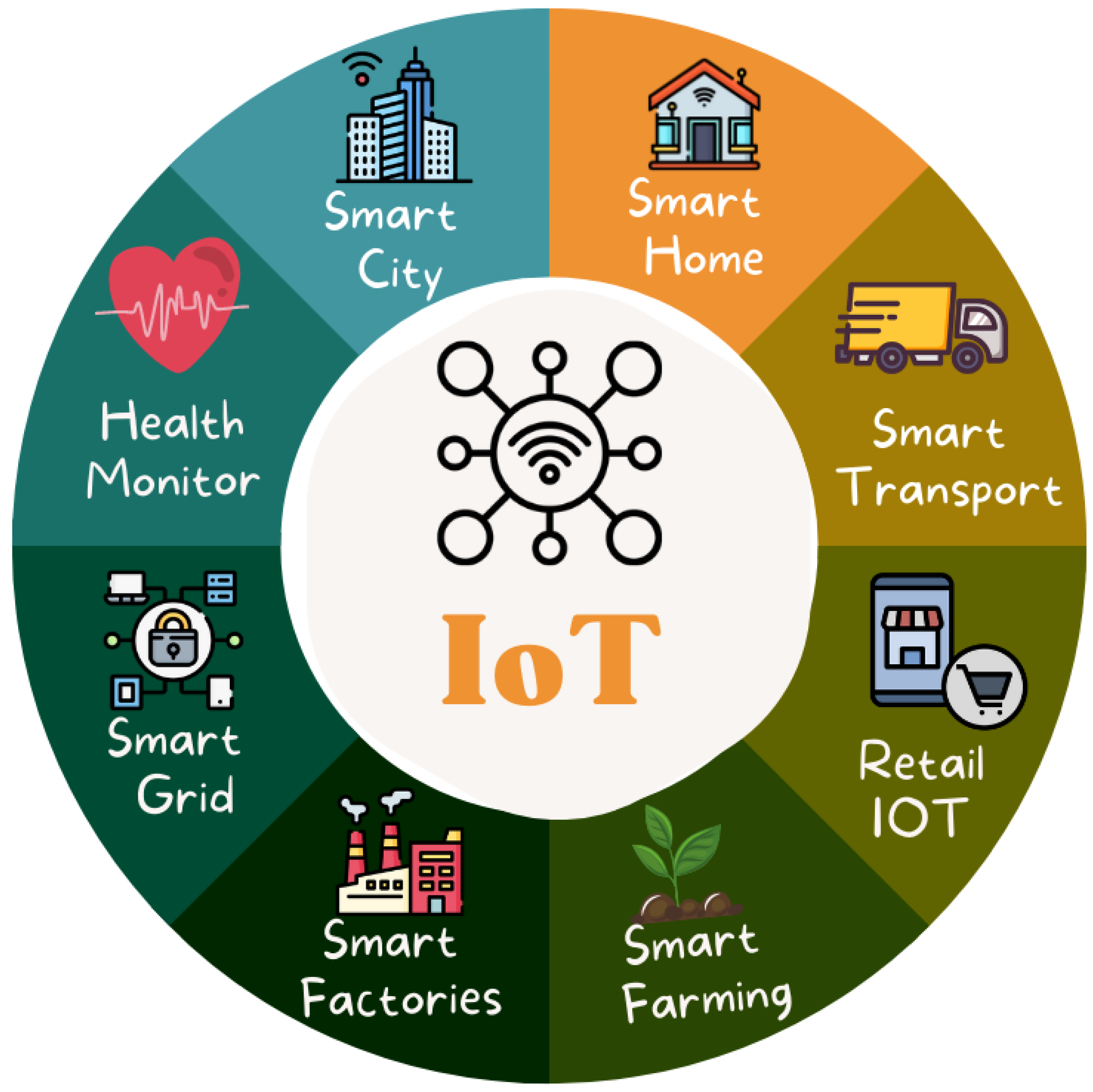
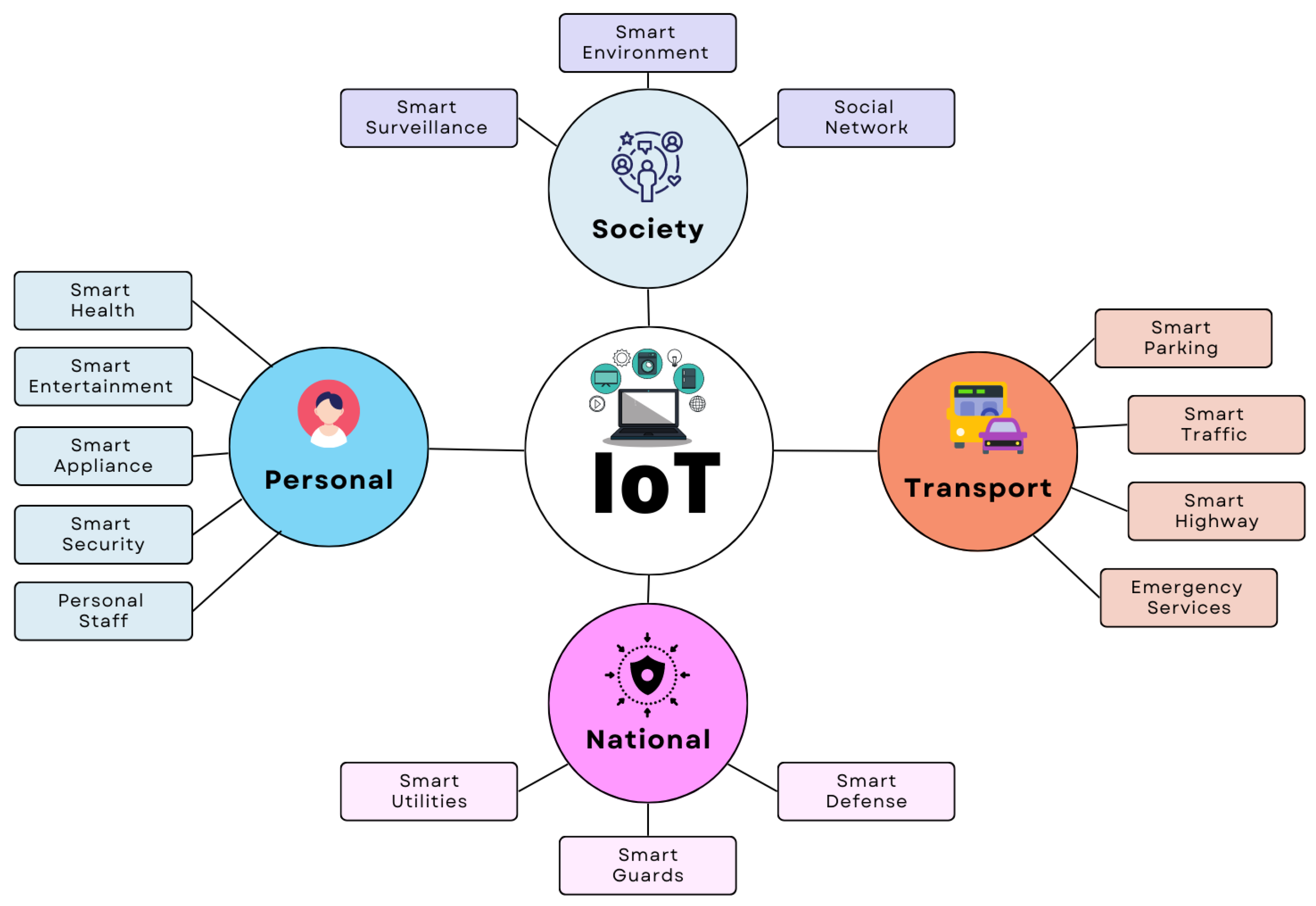
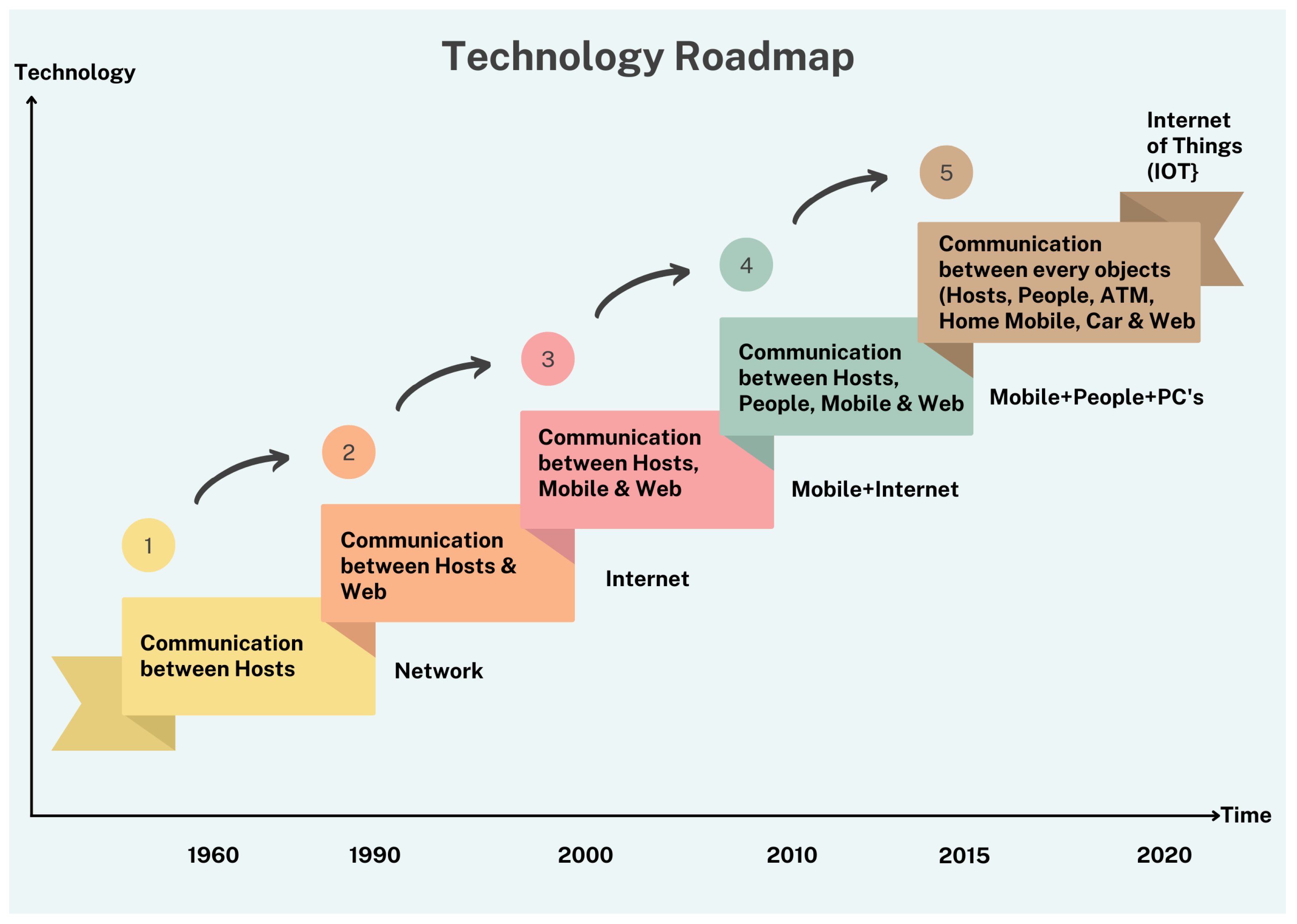


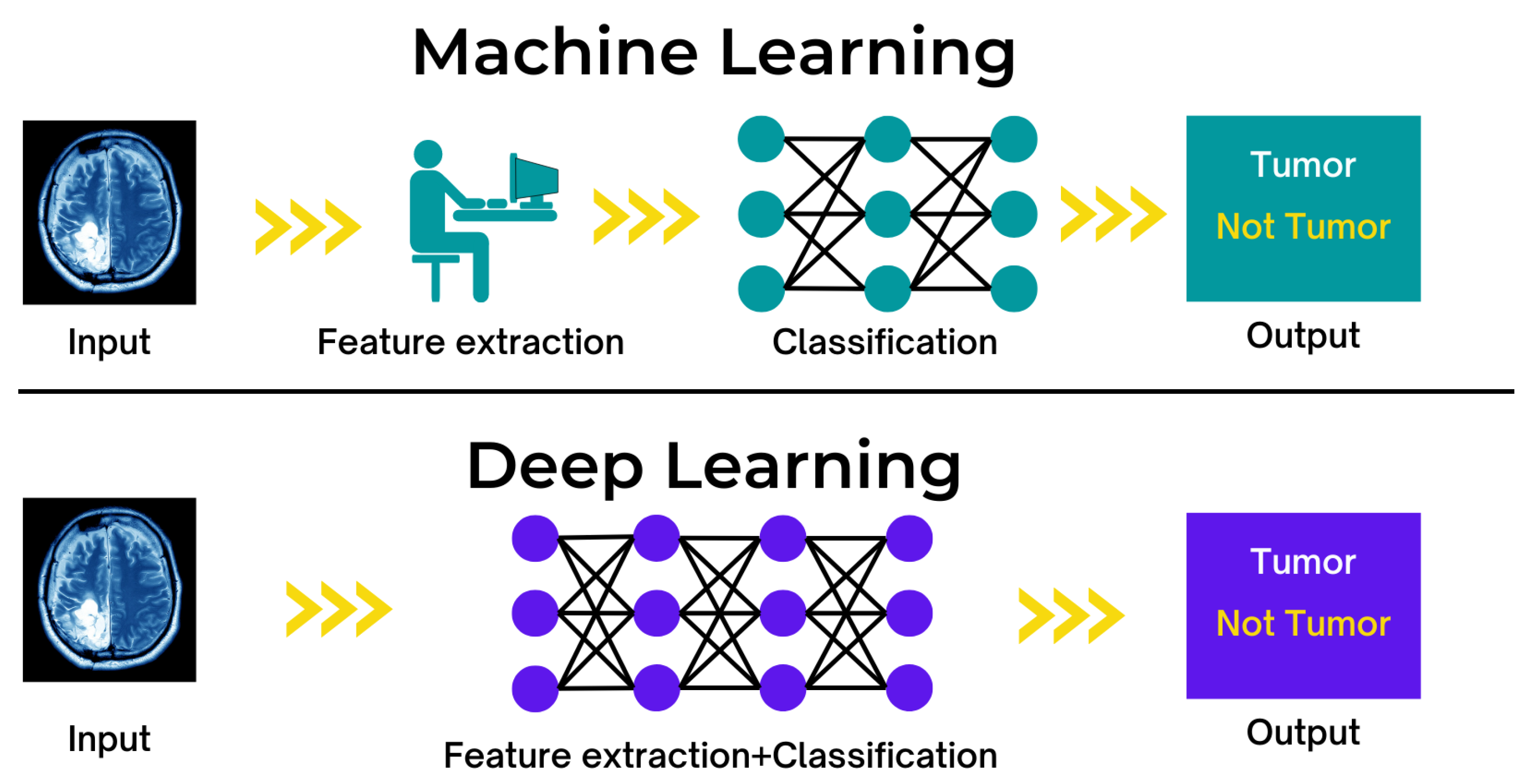

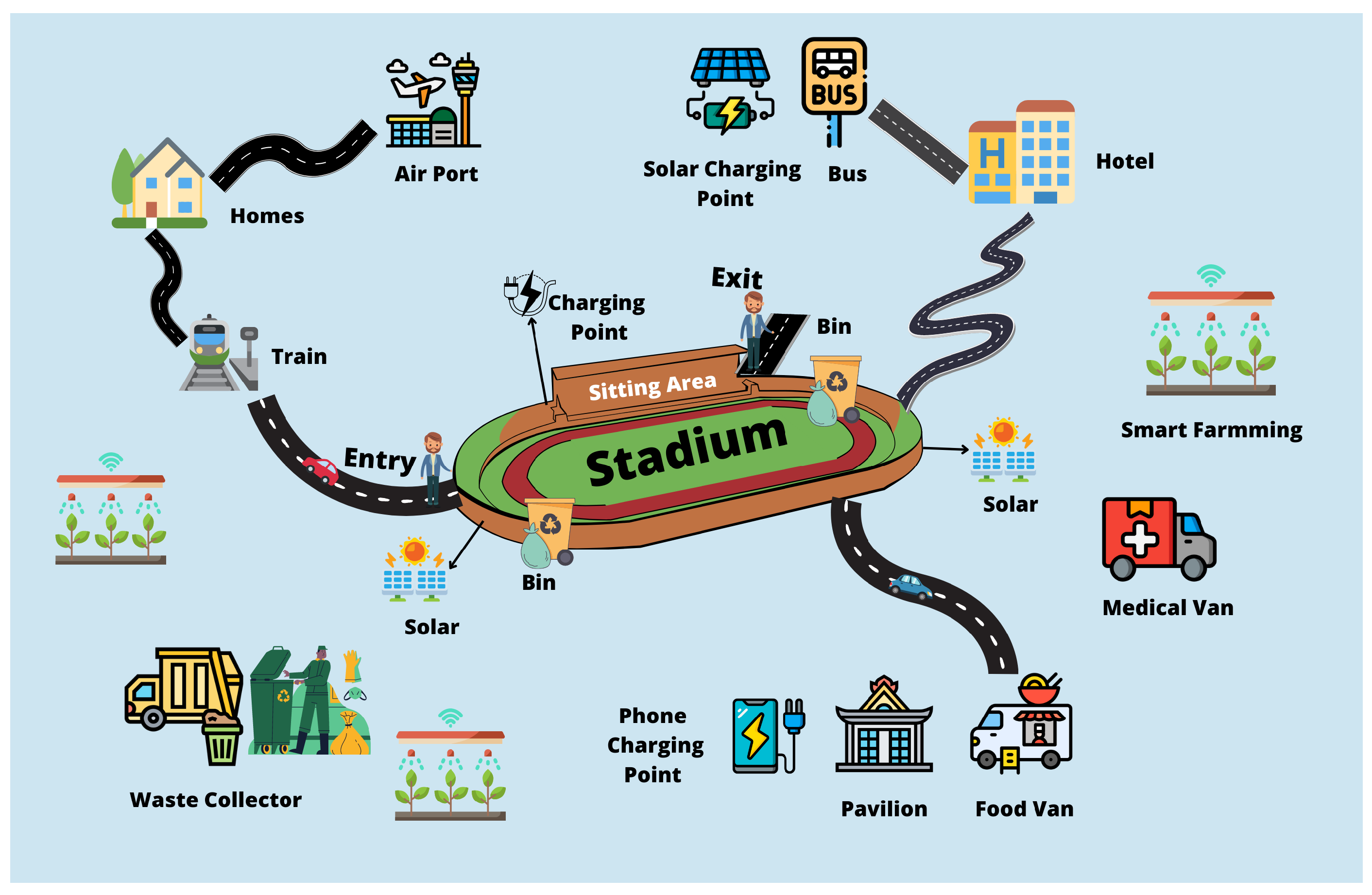
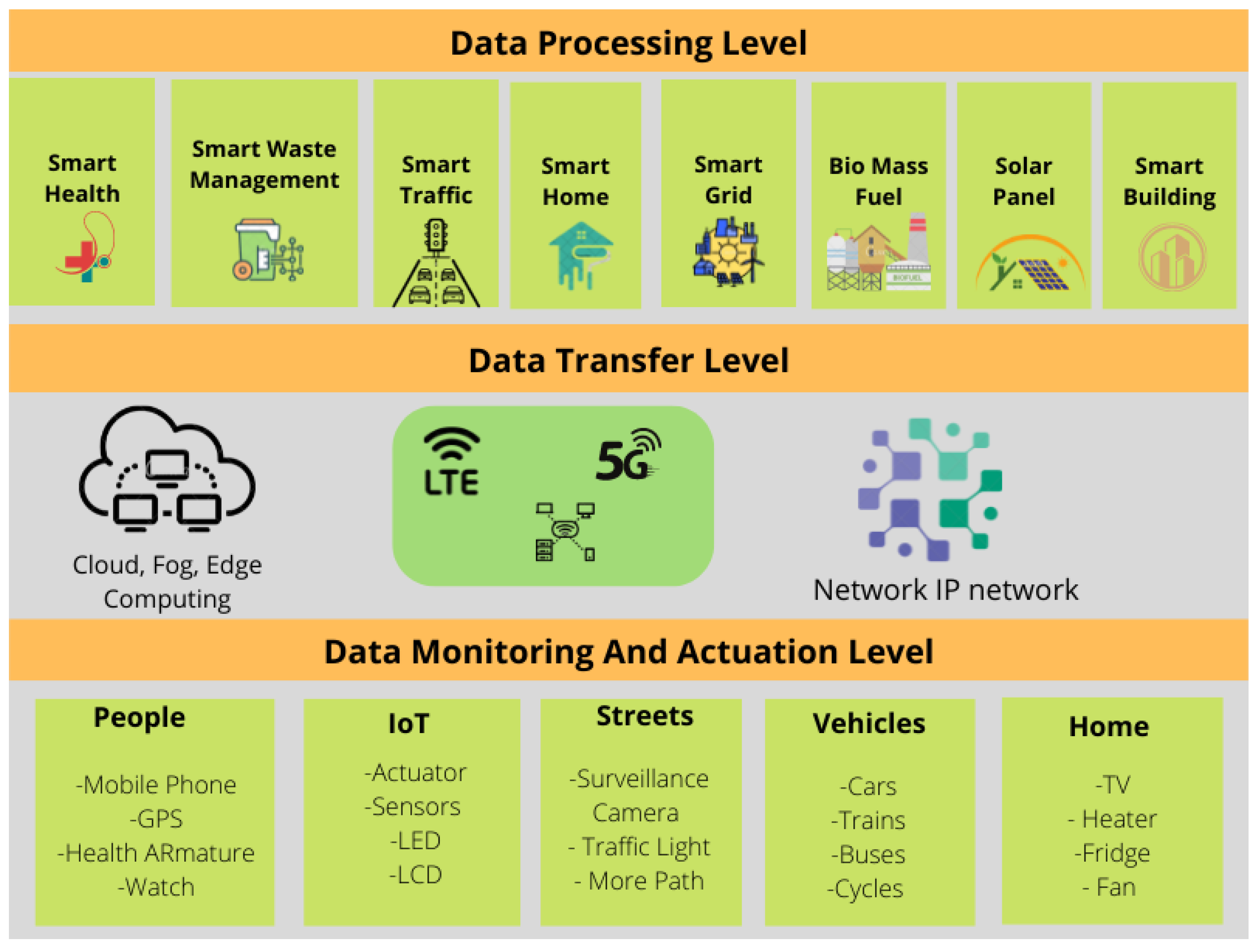


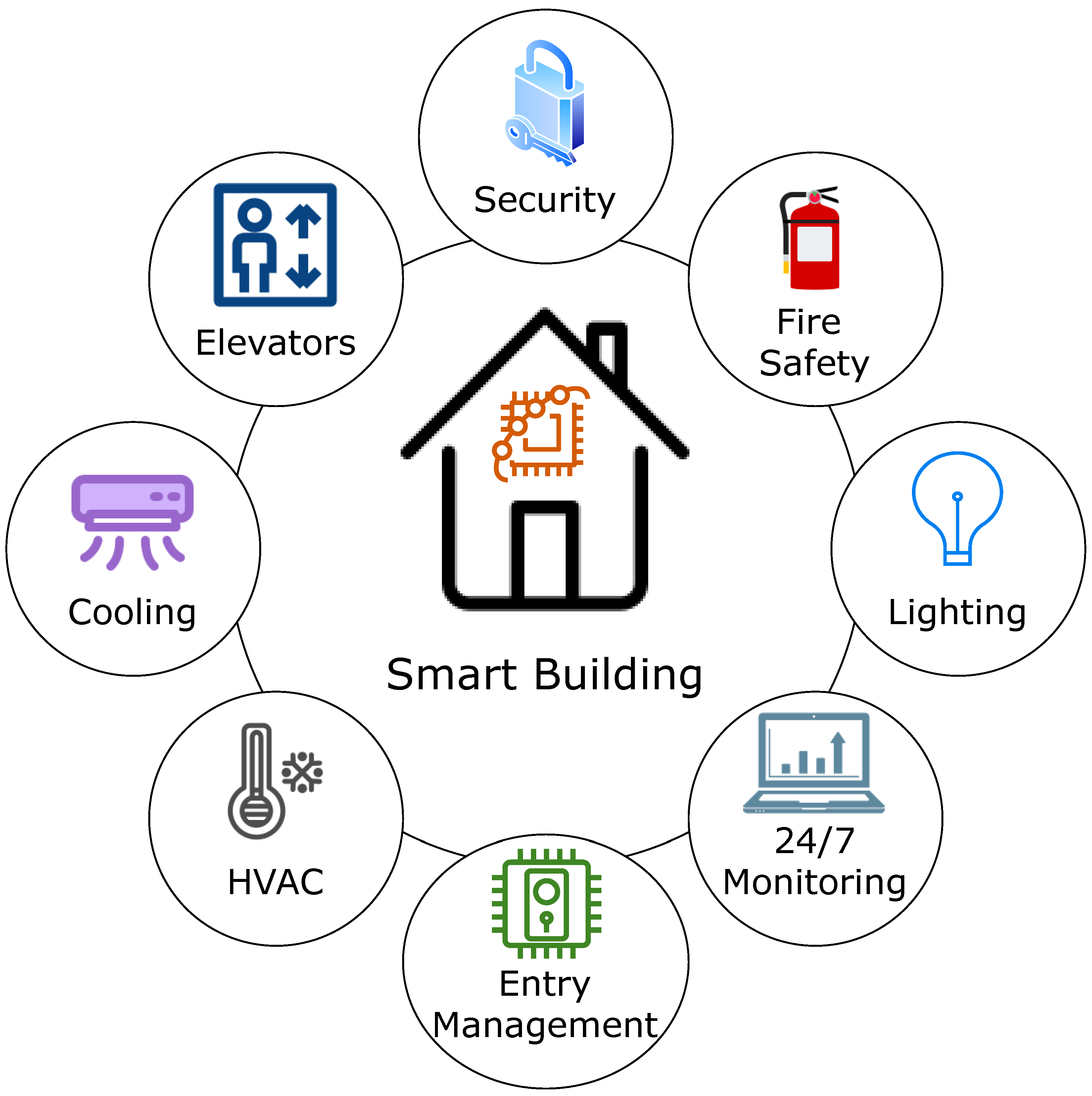
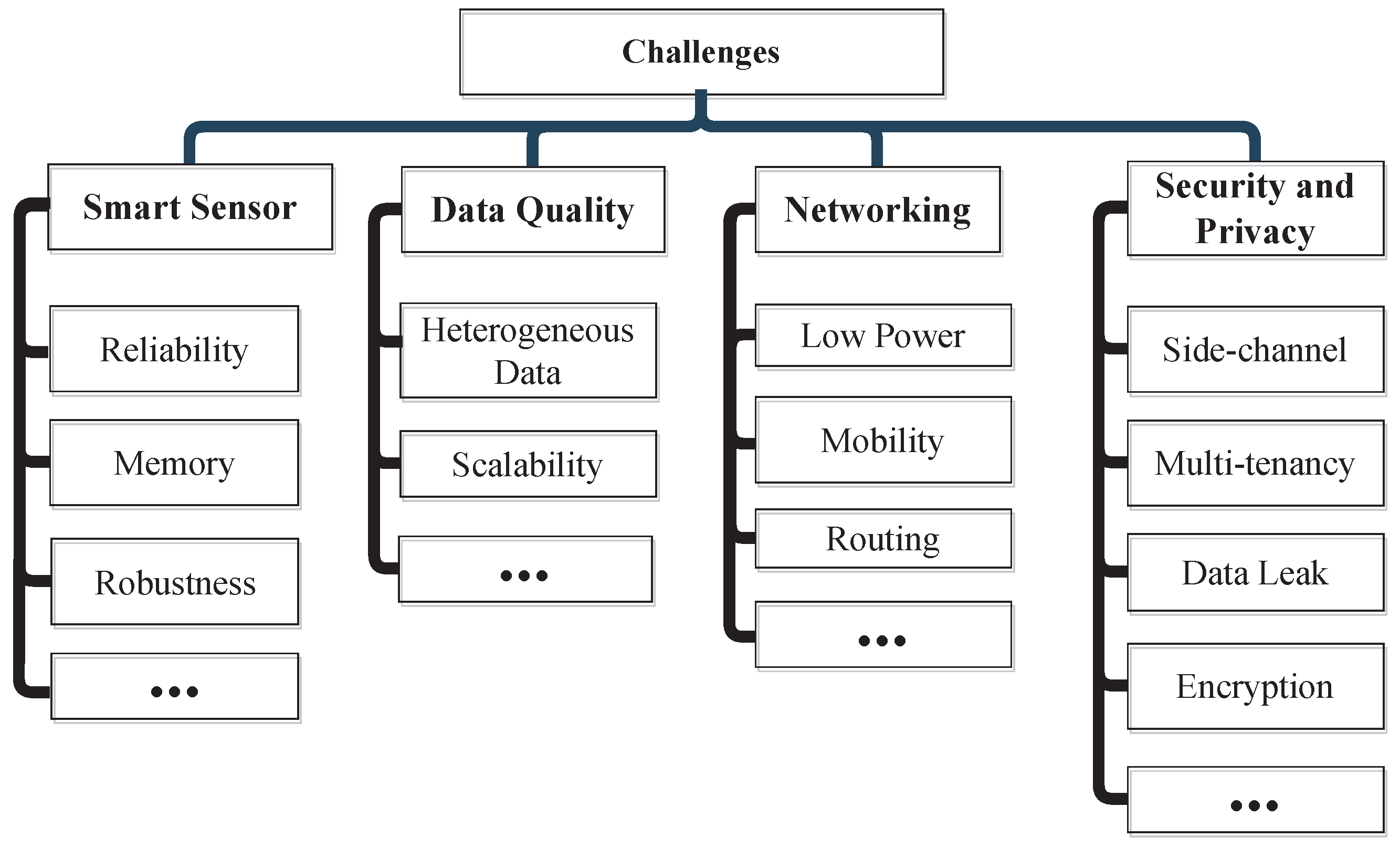
| Reference | Technology | Frequency | Data Rate | Range | Used For | Main Application Area |
|---|---|---|---|---|---|---|
| [22] | ZigBee | 2.4 GHz | 250 Kbps, 100 Kbps, 40 Kbps, 20 Kbps | 10–100 m | Control and monitor applications | Home automation. |
| [23] | Actuator | 100 Hz | 10Mbps | — | Produces mechanical motion by converting the energy in a control signal | Smart Lighting, Air conditioning in home. |
| [24,25] | MQTT | 10 Hz, 2 Hz, 1 Hz | 1 Mbps | 256 m | Interconnect devices | Transport System |
| [26,27] | Ad-hoc | 2.4 GHz | 10 Kbps | 100 m | Helps in emergencies | Smart Health. |
| [28] | GPS | 1575.42 MHz, 1227.6 MHz | 50 Mbps | 500–30 cm | Show precise location of an element | Waste Management System, Smart Home, Smart Parking. |
| City | Strategies |
|---|---|
| Singapore | Establishing video consultations, monitor patients remotely, vehicle free city. |
| Oslo | Energy saving adjusting traffic lights, electric vehicles, free parking. |
| New York | WiFi-based charging stations, car sharing reduces emission and traffic congestion. |
| London | 5G connectivity, fibre-optic coverage, lampposts, electric vehicle charging points. |
| Copenhagen | Smart parking, monitor air quality and traffic lighting, energy consumption. |
| Challenge | Solution | Reference |
|---|---|---|
| Reliability | Decentralized and distributed architectures and decision making, Energy Efficient | [16] |
| Assuring data quality | Cost effective, Efficient Data gathered might be resolved | [24] |
| Security and Privacy | Prevent data leaks, Ensure that their sensitive data has private access, New authentication techniques, Encryption, Steer clear of theft and unethical manipulation | [93] |
| Smart Sensors | Enable measurement, inference, and comprehension of environmental indicators, Low power sensors, High efficiency, encouraging interoperability | [93,94] |
| Networking | Low power networks, | [95] |
| Big data | Scalable, Efficient, Big data processing centers that are centralized, give sensitive data data anonymity | [96,97] |
| Large Scale | Provide storage and computational capability to extract new information, Handle delay | [97] |
Publisher’s Note: MDPI stays neutral with regard to jurisdictional claims in published maps and institutional affiliations. |
© 2022 by the authors. Licensee MDPI, Basel, Switzerland. This article is an open access article distributed under the terms and conditions of the Creative Commons Attribution (CC BY) license (https://creativecommons.org/licenses/by/4.0/).
Share and Cite
Whaiduzzaman, M.; Barros, A.; Chanda, M.; Barman, S.; Sultana, T.; Rahman, M.S.; Roy, S.; Fidge, C. A Review of Emerging Technologies for IoT-Based Smart Cities. Sensors 2022, 22, 9271. https://doi.org/10.3390/s22239271
Whaiduzzaman M, Barros A, Chanda M, Barman S, Sultana T, Rahman MS, Roy S, Fidge C. A Review of Emerging Technologies for IoT-Based Smart Cities. Sensors. 2022; 22(23):9271. https://doi.org/10.3390/s22239271
Chicago/Turabian StyleWhaiduzzaman, Md, Alistair Barros, Moumita Chanda, Supti Barman, Tania Sultana, Md. Sazzadur Rahman, Shanto Roy, and Colin Fidge. 2022. "A Review of Emerging Technologies for IoT-Based Smart Cities" Sensors 22, no. 23: 9271. https://doi.org/10.3390/s22239271
APA StyleWhaiduzzaman, M., Barros, A., Chanda, M., Barman, S., Sultana, T., Rahman, M. S., Roy, S., & Fidge, C. (2022). A Review of Emerging Technologies for IoT-Based Smart Cities. Sensors, 22(23), 9271. https://doi.org/10.3390/s22239271






